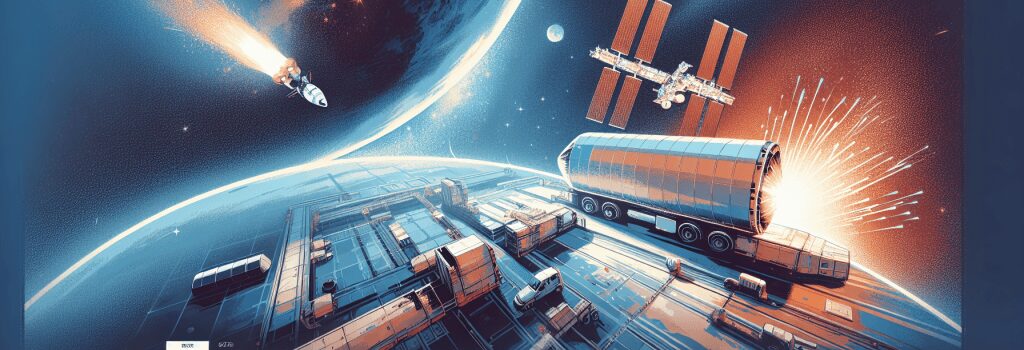NASA Postpones Cygnus NG-22 Launch After Cargo Module Damage: A Deep Dive into ISS Supply Challenges

In a setback for the International Space Station (ISS) resupply program, NASA has confirmed that the Cygnus spacecraft designated for the NG-22 mission will not be launched as scheduled. The spacecraft, built by Northrop Grumman, incurred damage to its cargo module while en route to the Florida launch site, leading to an extensive evaluation of its integrity and performance capabilities.
Incident Overview and Initial Evaluation
Three weeks ago, NASA disclosed that a shipping container dedicated to protecting the Cygnus spacecraft suffered notable damage during transit. The initial assessment raised concerns over the structural integrity of the cargo module. NASA’s statement noted, “Following initial evaluation, there also is damage to the cargo module.” As a result, the NG-22 mission, which was slated for a June launch, has been sidelined pending further analysis.
Northrop Grumman, a key partner in ISS logistics, is now collaborating with NASA to determine if the damaged Cygnus module could be safely refurbished or if its role should be shifted to a future mission manifest. Early indications suggest that the integrity of the module has been compromised to the point where a near-term launch is unfeasible.
Implications for ISS Resupply and Alternative Options
With the NG-22 mission postponed, NASA has shifted focus to mitigating the potential supply shortfall on the ISS. The agency is modifying cargo allocations on the upcoming 32nd SpaceX Cargo Dragon mission, scheduled for an April launch. The Dragon spacecraft will now carry additional consumable supplies and food to bolster the station’s reserve levels.
NASA is exploring other options to compensate for the setback. Among the alternatives is the possibility of utilizing Boeing’s Starliner spacecraft to ferry cargo. Although Starliner faced propulsion challenges during its recent crewed flight test, engineers are assessing whether the vehicle could be certified for an uncrewed cargo mission. However, logistical hurdles, such as competition for docking ports on the ISS with SpaceX’s crew missions, add complexity to this potential workaround.
Deep Analysis: Technical Specifications and Damage Assessment
The Cygnus spacecraft, part of Northrop Grumman’s contribution to the Commercial Resupply Services program, boasts a robust design capable of delivering a wide array of supplies including food, water, and scientific experiments. However, the recent damage alleged to be within the cargo module calls into question certain structural and thermal properties of the integrated system. Engineers are scrutinizing the integrity of critical components such as the pressure vessel, thermal insulation layers, and avionics enclosures. Detailed non-destructive testing (NDT) protocols, including ultrasonic and radiographic inspections, are being considered to accurately gauge the extent of the damage.
Expert analyses suggest that even minor deviations in expected structural performance could impose significant risk during the re-entry phase or while rendezvousing with the ISS. This incident reinforces the importance of rigorous pre-launch checks and robust packaging systems during logistical transfers.
Future Missions and Long-Term Strategies
In light of the Cygnus setback, NASA’s long-term strategy leans heavily on the reliability of SpaceX’s Falcon 9 and Dragon spacecraft for both cargo and crewed missions. Crew Dragon remains the only vehicle fully certified by NASA for human transport, and current operations ensure a continuous feed of supplies to the ISS leveraging SpaceX’s extensive launch cadence.
Northrop Grumman is also exploring the development of a new rocket in collaboration with Firefly Aerospace. However, until these alternative systems are fully vetted and operationally ready, every non-Russian cargo mission to the ISS will rely on SpaceX’s Falcon 9 launch vehicle.
Expert Opinions and Broader Industry Impact
Industry experts have highlighted that while the setback is significant, it underscores the inherent complexities of space logistics. Dr. Margaret Li, a specialist in spacecraft systems at the Orbital Engineering Institute, noted, “Incidents like these, although unfortunate, are valuable learning opportunities. They push the envelope of engineering scrutiny and lead to enhanced safety protocols across the industry.”
Furthermore, the reliance on SpaceX’s Falcon 9 is seen by many as a double-edged sword. While it reinforces the company’s market dominance in ISS resupply missions, it also points to an urgent need for diversified logistics capabilities to safeguard against single-source dependencies. Technical experts and analysts are urging increased investment in backup systems, such as Boeing’s Starliner and Sierra Nevada Corporation’s Dream Chaser. However, these systems are still mired in development delays and further complications such as the unavailability of dedicated launch vehicles like the Vulcan rocket for Dream Chaser.
Conclusion
The postponement of the Cygnus NG-22 mission due to cargo module damage represents a significant disruption in NASA’s meticulously planned resupply schedule. While temporary measures, including an augmented SpaceX Dragon mission, will bridge the supply gap, the long-term focus remains on diversifying and strengthening the ISS’s supply chain network. The challenges encountered also serve as a reminder of the rigorous technical standards and risk management strategies necessary for sustaining long-duration space missions.
- NASA emphasizes safety and technical integrity over launch schedules.
- SpaceX continues to play a pivotal role in ISS resupply amidst evolving challenges.
- Future validation of alternative spacecraft like Starliner and Dream Chaser is critical to enhance operational resiliency.
Source: Ars Technica